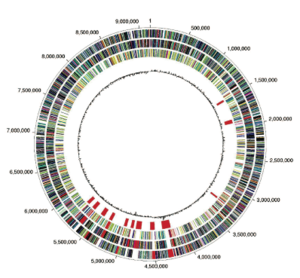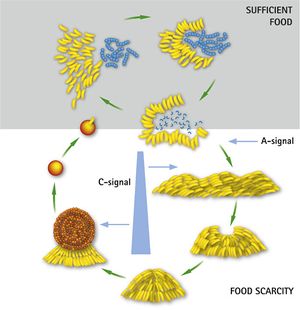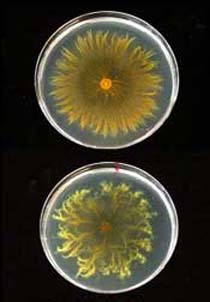Myxococcus xanthus: Difference between revisions
No edit summary |
No edit summary |
||
| (60 intermediate revisions by 2 users not shown) | |||
| Line 1: | Line 1: | ||
{{Uncurated}} | |||
==Classification== | ==Classification== | ||
Bacteria; Proteobacteria; Deltaproteobacteria; Mxyococcales; xanthus | Bacteria; Proteobacteria; Deltaproteobacteria; Mxyococcales; Myxococcus; xanthus | ||
==Description and Significance== | ==Description and Significance== | ||
''Myxococcus xanthus'' is a soil bacterium that form cooperative hunting groups. The group swarms through the soil and preys upon other bacteria. Once a bacterium is found, the pack secretes digestive enzymes that release nutrients into the environment that ''M. xanthus'' can take up and metabolize. ''M. xanthus'' can structure communties by having a top-down effect on the microbial communities and alter the composition of prey species. | |||
==Genome Structure== | ==Genome Structure== | ||
==Cell | [[Image:MyxoGenomeMap2.png|thumb|left|alt=MyxococcusGenomeMap|''M. xanthus'' Genome Map]] | ||
The genome of ''Myxococcus xanthus'' was sequenced in 2001 and released to the public. In 2006, The Institute for Genomic Research completed the genome. The complete genome is 9.14 Mb long which is contained in a single chromosome and has a GC content of 69%. The length of the ''M. xanthus'' genome is much larger than many other delta-proteobacteria, which may be due to its complex, cooperative lifestyle in its soil environment. The genome encodes nearly 7,500 genes. | |||
Along with completion of the genome in 2006, Goldman and colleagues (2006) examined the genome to see why there was a length discrepancy between ''M. xanthus'' and other delta-proteobacteria. By comparing the genomes with other genomes of sequenced delta-proteobacteria, they found that at least 1,500 of the genes were lineage-specific, meaning that they were duplicated and have diverged over evolutionary time. The authors state that more than the 1,500 genes with a lineage-specific, but were excluded due the stringent criteria used in their analysis. Within the lineage-specific gene duplications are genes that code for STPKs, sigma-54 activator proteins, and two-component regulatory systems. | |||
In 2007, Goldman et al. looked at the genes involved in fruiting body development and found that 73% of the genes involved in this process are lineage specific. However, 22% of the genes have different codon biases or altered phylogeny suggesting that these genes were obtained through horizontal gene transfer and indicating that genes obtained laterally were essential to the ''M. xanthus'' life cycle. | |||
==Cell Structure, Metabolism and Life Cycle== | |||
[[Image:MyxococcusLifeCycle.jpeg|thumb|right|alt=Mycoccus Life Cycle|''M. xanthus'' Life Cycle]] | |||
''Myxococcus xanthus'' is a gram negative, rod-shaped, ubiquitous soil bacterium. It is classified as a chemoorganotroph, meaning that it obtains its energy by oxidizing organic compounds. ''M. xanthus'' is very abundant in the soil reaching high densities per gram of soil. They are a predatory bacteria that hunt for prey by cooperating to form a groups of cells that swarms through the soil. The group of cells feed on bacteria that they come across by secreting digestive enzymes and feeding on the nutrients. | |||
''M. xanthus'' is an auxotroph for several essential amino acids, including isoleucine, leucine, valine, and vitamin B12 (for the synthesis of methionine), and depends on this behavior to survive and obtain the required nutrients for growth. Pyruvate is the most efficient source of cellular carbon, and most tricarboxylic acid cycle intermediates are less efficient sources of carbon. Studies show that mono- and disaccharides are not efficient sources of carbon-energy. When starved for nutrients the group of ''M. xanthus'' cells undergo a develomental change in which the cells form a fruiting body in which contains spores that can disperse and rejuvenate into motile cells when they sense that prey are around. | |||
==Motility== | |||
''Myxococcus xanthus'' has pili which facilitates gliding motility. The pili are found only at the cell poles. ''M. xanthus'' has two patterns of cell movement: adventurous (A-motility) and social (S-motility). Each type of motility is governed by a separate gene system called system A and system S, respectively. A-motility does not require the use of pili, and is characterized by single, isolated cells, whereas S-motility requires the use of pili and is characterized by many groups of cells. | |||
[[Image:Social_swarming.jpeg|thumb|right|alt=Social Swarming|Socially mediated pack swarming in ''M. xanthus.'']] | |||
==Predation== | |||
If there is enough food in the environment, ''M. xanthus'' will swarm and predate. ''M. xanthus'' uses cell-cell interactions to behave cooperatively when hunting for food. Predation of involves the release of toxic and lytic substances that immobilize and degrade prey organisms, thereby creating a public pool of growth substances. Predation involves the secretion of over 300 secondary metabolites, such as myxalamid, an antibiotic that targets yeasts, molds, and enterobacteria. | |||
==Ecology and Pathogenesis== | ==Ecology and Pathogenesis== | ||
*''Myxococcus xanthus'' is not a pathogenic bacterium. | |||
*Ecological Variables Affecting Predatory Success - In 2007, Hillesland and colleagues set out to determine the ecological variables that influence the ability of ''M. xanthus'' to search for and consume prey. The variables that they tested were different buffered substrates (hard or soft agar), different prey types (''E. coli'' or ''M. luteus''), and two different prey densities (1 cm or 2 cm grids). They found that the more prey patches were encountered when prey density was high and that a greater proportion of prey patches were encountered on hard agar than on soft agar for both prey types. In addition, the researchers found that depending on the environment, different prey species were encountered more frequently. On hard agar, ''M. xanthus'' encountered and consumed ''E. coli'' more frequently than ''M. luteus'' at high and low prey densities. However, on soft agar at high patch density, ''M. luteus'' was encountered and consumed more frequently. The researchers also found that different ecological variables had no effect on prey killing. | |||
*Social Conlict at Different Scales - Vos and Velicer (2009) looked at cooperative sporulation in ''M. xanthus'' and how conflict arises at different scales. To examine conflict at different scales, the researchers isolated clones in a 16 x 16 cm patch of soil and looked at chimeras during fruiting body formation and the production of spores. They compared this data to a previous study where the reserachers isolated clones from around the globe and looked the the formation of fruiting bodies and the composition of spores. The researchers found that conflict occurs even at local scales and that this is due to the diversificaiton of clones in spatially heterogenous soil environments. | |||
==Current Research and Implications== | |||
For decades, ''M. xanthus'' has been studied as a model organism for self-organization. Other topics under study are the sporulating proteins of ''M. xanthus'', the genes associated with different motility systems, and the molecules associated with cell-cell signaling. | |||
During predation, ''M. xanthus'' secretes many compounds that have antibiotic properties, such as myxalamid. There is ongoing research aimed at genetically modifying ''M. xanthus'' to overproduce these compounds in a controlled environment. Also, current research is aimed at the heterologous production of Epothilone B, a polyketide capable of targeting breast cancer cells. Research is conducted on the potential agricultural use of ''M. xanthus'', which can act as a bacterial biological control agent to inhibit pathogenic fungi in plants. | |||
==References== | ==References== | ||
[http://www.pnas.org/content/76/11/5952.full.pdf+html Kaiser D. Social gliding is correlated with the presence of pili in ''Myxococcus xanthus''. PNAS. 1979. Vol.76, No.1, pp.5952-5956.] | |||
[http://www.pnas.org/content/103/41/15200.full.pdf+html Goldman B.S., Nierman W.C., Kaiser D., Slater S.C., Durkin A.S., Eisen J.A., Ronning C.M., Barbazuk W.B., Blanchard M., Field C., Halling C., Hinkle G., Iartchuk O., Kim H.S., Mackenzie C., Madupu R., Miller N., Shvartsbeyn A., Sullivan S.A., Vaudin M., Wiegand R., Kaplan H.B. Evolution of sensory complexity recorded in a myxobacterial genome. PNAS. 2006. Vol.103, No 41, pp.15200-15205.] | |||
[http://www.ncbi.nlm.nih.gov/pmc/articles/PMC222085/pdf/jbacter00297-0331.pdf Bretscher A.P., Kaiser D. Nutrition of ''Myxococcus xanthus'', a fruiting myxobacterium. Jour. of Bact. 1978. pp.763-768.] | |||
[http://www.ncbi.nlm.nih.gov/pmc/articles/PMC2858270/pdf/nihms156769.pdf?tool=pmcentrez Vos, M. and G. J. Velicer. 2009. Social conflict in centimeter- and global-scale populations of the bacterium ''Myxococcus xanthus''. Current Biology, 19: 1763-1767.] | |||
[http://www.ncbi.nlm.nih.gov/pubmed?term=Ecological%20variables%20affecting%20predatory Hillesland, K.L., R.E. Lenski, and G.J. Velicer. 2007. Ecological variables affecting predatory success in ''Myxococcus xanthus''. Microbial Ecology, 53(4): 571-578.] | |||
[http://www.ncbi.nlm.nih.gov/pmc/articles/PMC2129111/pdf/pone.0001329.pdf?tool=pmcentrez Goldman B, Bhat S, Shimkets LJ. 2007. Genome Evolution and the Emergence of Fruiting Body Development in ''Myxococcus xanthus''. PLoS ONE 2(12): e1329.] | |||
http://www.bio.indiana.edu/faculty/directory/profile.php?person=gvelicer | |||
http://en.citizendium.org/wiki/Myxococcus_xanthus | |||
==Authors== | ==Authors== | ||
Page authored by Devin Dobias and Suhas | Page authored by Devin Dobias and Suhas Devangam, Students of Prof. Jay Lennon, at Michigan State University. | ||
Latest revision as of 15:29, 8 July 2011
Classification
Bacteria; Proteobacteria; Deltaproteobacteria; Mxyococcales; Myxococcus; xanthus
Description and Significance
Myxococcus xanthus is a soil bacterium that form cooperative hunting groups. The group swarms through the soil and preys upon other bacteria. Once a bacterium is found, the pack secretes digestive enzymes that release nutrients into the environment that M. xanthus can take up and metabolize. M. xanthus can structure communties by having a top-down effect on the microbial communities and alter the composition of prey species.
Genome Structure
The genome of Myxococcus xanthus was sequenced in 2001 and released to the public. In 2006, The Institute for Genomic Research completed the genome. The complete genome is 9.14 Mb long which is contained in a single chromosome and has a GC content of 69%. The length of the M. xanthus genome is much larger than many other delta-proteobacteria, which may be due to its complex, cooperative lifestyle in its soil environment. The genome encodes nearly 7,500 genes.
Along with completion of the genome in 2006, Goldman and colleagues (2006) examined the genome to see why there was a length discrepancy between M. xanthus and other delta-proteobacteria. By comparing the genomes with other genomes of sequenced delta-proteobacteria, they found that at least 1,500 of the genes were lineage-specific, meaning that they were duplicated and have diverged over evolutionary time. The authors state that more than the 1,500 genes with a lineage-specific, but were excluded due the stringent criteria used in their analysis. Within the lineage-specific gene duplications are genes that code for STPKs, sigma-54 activator proteins, and two-component regulatory systems.
In 2007, Goldman et al. looked at the genes involved in fruiting body development and found that 73% of the genes involved in this process are lineage specific. However, 22% of the genes have different codon biases or altered phylogeny suggesting that these genes were obtained through horizontal gene transfer and indicating that genes obtained laterally were essential to the M. xanthus life cycle.
Cell Structure, Metabolism and Life Cycle
Myxococcus xanthus is a gram negative, rod-shaped, ubiquitous soil bacterium. It is classified as a chemoorganotroph, meaning that it obtains its energy by oxidizing organic compounds. M. xanthus is very abundant in the soil reaching high densities per gram of soil. They are a predatory bacteria that hunt for prey by cooperating to form a groups of cells that swarms through the soil. The group of cells feed on bacteria that they come across by secreting digestive enzymes and feeding on the nutrients.
M. xanthus is an auxotroph for several essential amino acids, including isoleucine, leucine, valine, and vitamin B12 (for the synthesis of methionine), and depends on this behavior to survive and obtain the required nutrients for growth. Pyruvate is the most efficient source of cellular carbon, and most tricarboxylic acid cycle intermediates are less efficient sources of carbon. Studies show that mono- and disaccharides are not efficient sources of carbon-energy. When starved for nutrients the group of M. xanthus cells undergo a develomental change in which the cells form a fruiting body in which contains spores that can disperse and rejuvenate into motile cells when they sense that prey are around.
Motility
Myxococcus xanthus has pili which facilitates gliding motility. The pili are found only at the cell poles. M. xanthus has two patterns of cell movement: adventurous (A-motility) and social (S-motility). Each type of motility is governed by a separate gene system called system A and system S, respectively. A-motility does not require the use of pili, and is characterized by single, isolated cells, whereas S-motility requires the use of pili and is characterized by many groups of cells.
Predation
If there is enough food in the environment, M. xanthus will swarm and predate. M. xanthus uses cell-cell interactions to behave cooperatively when hunting for food. Predation of involves the release of toxic and lytic substances that immobilize and degrade prey organisms, thereby creating a public pool of growth substances. Predation involves the secretion of over 300 secondary metabolites, such as myxalamid, an antibiotic that targets yeasts, molds, and enterobacteria.
Ecology and Pathogenesis
- Myxococcus xanthus is not a pathogenic bacterium.
- Ecological Variables Affecting Predatory Success - In 2007, Hillesland and colleagues set out to determine the ecological variables that influence the ability of M. xanthus to search for and consume prey. The variables that they tested were different buffered substrates (hard or soft agar), different prey types (E. coli or M. luteus), and two different prey densities (1 cm or 2 cm grids). They found that the more prey patches were encountered when prey density was high and that a greater proportion of prey patches were encountered on hard agar than on soft agar for both prey types. In addition, the researchers found that depending on the environment, different prey species were encountered more frequently. On hard agar, M. xanthus encountered and consumed E. coli more frequently than M. luteus at high and low prey densities. However, on soft agar at high patch density, M. luteus was encountered and consumed more frequently. The researchers also found that different ecological variables had no effect on prey killing.
- Social Conlict at Different Scales - Vos and Velicer (2009) looked at cooperative sporulation in M. xanthus and how conflict arises at different scales. To examine conflict at different scales, the researchers isolated clones in a 16 x 16 cm patch of soil and looked at chimeras during fruiting body formation and the production of spores. They compared this data to a previous study where the reserachers isolated clones from around the globe and looked the the formation of fruiting bodies and the composition of spores. The researchers found that conflict occurs even at local scales and that this is due to the diversificaiton of clones in spatially heterogenous soil environments.
Current Research and Implications
For decades, M. xanthus has been studied as a model organism for self-organization. Other topics under study are the sporulating proteins of M. xanthus, the genes associated with different motility systems, and the molecules associated with cell-cell signaling.
During predation, M. xanthus secretes many compounds that have antibiotic properties, such as myxalamid. There is ongoing research aimed at genetically modifying M. xanthus to overproduce these compounds in a controlled environment. Also, current research is aimed at the heterologous production of Epothilone B, a polyketide capable of targeting breast cancer cells. Research is conducted on the potential agricultural use of M. xanthus, which can act as a bacterial biological control agent to inhibit pathogenic fungi in plants.
References
http://www.bio.indiana.edu/faculty/directory/profile.php?person=gvelicer
http://en.citizendium.org/wiki/Myxococcus_xanthus
Authors
Page authored by Devin Dobias and Suhas Devangam, Students of Prof. Jay Lennon, at Michigan State University.



